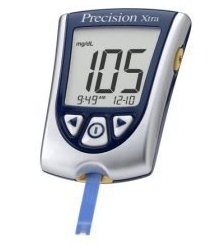 All About Glucose Levels
All About Glucose Levels
What Are Normal Glucose Levels
According to the American Diabetes Association, normal blood sugar levels for people who don’t have diabetes are 95 mg/dl or less when fasting, 140 mg/dl or less one hour after a meal, and 120 mg/dl or less two hours after a meal. Fasting blood glucose levels are taken first thing in the morning before eating breakfast.
High Blood Glucose Levels
A diagnosis of diabetes requires a blood glucose test. There are a few different tests that can be used to make this diagnosis. A random plasma glucose test is the simplest. This test can be given at any time, whether you have eaten recently or not. If the test result shows a blood glucose level of 200 mg/dl or higher, the diagnosis will be confirmed.
Another test that can be used to validate that diagnosis is a fasting plasma glucose test. This test is usually administered in the morning, since you cannot eat for 8 to 10 hours prior to the test. If your blood glucose level is 126 mg/dl or higher, you may have problems needing treatment. Two results of 126 mg/dl or higher on separate days are required to make a diagnosis. If your results on this test are above 100 mg/dl but below 126 mg/dl, you may be diagnosed with pre-diabetes.
People with pre-diabetes should monitor their sugar levels on a regular basis and be aware of dangerous symptoms so that they will recognize them if they appear. The most common symptoms are extreme thirst, frequent urination, weight loss, fatigue, and blurred vision.
Low Blood Glucose Levels
Hypoglycemia occurs when blood glucose levels drop too low. This condition doesn’t normally occur in non-diabetics because their bodies stop producing insulin when it is not needed. However, many diabetics experience hypoglycemia from time to time because the insulin or diabetic medication that is used to control those levels can work too well and cause blood glucose to drop too low. There are a lot of variables that affect the amount of insulin needed by the body, so it is nearly impossible to get the dosage exactly right all of the time, no matter how careful you are. For this reason, all diabetics should be aware of the symptoms of hypoglycemia and know how to treat it.
The level at which a person begins to experience symptoms of hypoglycemia varies, but it is usually around 70 mg/dl. Symptoms include dizziness, shakiness, sweating, and feeling faint. The treatment is to consume about 15 grams of fast-acting carbohydrates in order to quickly boost your glucose levels. Many diabetics carry glucose tablets for this purpose. Other options include drinking 4 ounces of regular (not diet) soda, drinking 4 ounces of orange juice, or eating a few small candies, such as jelly beans or LifeSavers.
Monitoring glucose levels helps diabetics control their blood sugar levels in order to prevent the complications of the disease. People who have diabetes usually try to keep their fasting levels in the range of 70-130 mg/dl and their glucose levels in blood following a meal under 180 mg/dl. This range is considered good glycemic control for diabetics. Glycemic control is essential to keeping normal levels and it will take some trial and error to achieve the best control for each person.